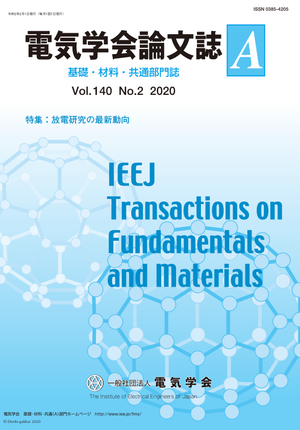Influence of Absolute Humidity and Saturation Deficit on Air Discharge Currents from Electrostatic Discharge Generator with Three Different Approach Speeds
Influence of Absolute Humidity and Saturation Deficit on Air Discharge Currents from Electrostatic Discharge Generator with Three Different Approach Speeds
カテゴリ: 論文誌(論文単位)
グループ名: 【A】基礎・材料・共通部門
発行日: 2020/02/01
タイトル(英語): Influence of Absolute Humidity and Saturation Deficit on Air Discharge Currents from Electrostatic Discharge Generator with Three Different Approach Speeds
著者名: Takeshi Ishida (Noise Laboratory Co., LTD), Osamu Fujiwara (Noise Laboratory Co., LTD/The University of Electro-Communications)
著者名(英語): Takeshi Ishida (Noise Laboratory Co., LTD), Osamu Fujiwara (Noise Laboratory Co., LTD/The University of Electro-Communications)
キーワード: air discharge,absolute humidity,saturation deficit,IEC specified and non-specified climatic range,discharge current,measurement
要約(英語): The International Electro-technical Commission (IEC) specifies air discharge immunity testing for electronic equipment in the standard 61000-4-2 under the climatic conditions of relative humidity from 30 to 60% and ambient temperature from 15 to 35 degrees Celsius. As aiming to improve the testing reproducibility, to clarify effects of the above climatic parameters on air discharge testing, we previously measured air discharge currents from an electrostatic discharge (ESD) generator with an approach speed of 80 mm/s under 6 combinations of relative humidity and temperature. The result showed that the same absolute humidity provides almost similar waveforms of the discharge currents despite different relative humidity and temperature. In this study, to further examine such combined effects, we measure air discharge currents from the ESD generator at a test voltage of 15 kV with three different approach speeds of 20 mm/s, 50 mm/s and 80 mm/s under 9 combinations of relative humidity (RH) and temperature inside and outside the IEC specified climatic ranges. As a result, air discharge current behavior is affected by not only absolute humidity (AH) but also saturation deficit (SD), or the difference between the AH and the saturated water vapor amount. The humidity dependence of peak currents differs according to the IEC specified and non-specified climatic ranges, which can better be explained by the SD. Under the IEC specified conditions over 30% RH, at faster approach speeds, the peak currents of air discharges have maximum values at AH7.70 g/m3 and SD15.36 g/m3, whereas they are 1.2 to 1.4 times larger compared to those at almost the same AH7.71 g/m3 and smaller SD5.14 g/m3. In the IEC non-specified climatic range less than 20% RH, however, regardless of the approach speeds, the current peaks noticeably reach maximum values at AH3.81 g/m3 and SD19.26 g/m3, which are 3.6 to 5.2 times larger than those at roughly the same AH3.96 g/m3 and larger SD35.64 g/m3. The above finding indicates that, under the same AH conditions, the maximum current peaks tend to be higher as the SD increases under over 30% RH conditions, whereas they rapidly increase as the SD decreases under less than 20% RH conditions.
本誌: 電気学会論文誌A(基礎・材料・共通部門誌) Vol.140 No.2 (2020) 特集:放電研究の最新動向
本誌掲載ページ: 98-102 p
原稿種別: 論文/英語
電子版へのリンク: https://www.jstage.jst.go.jp/article/ieejfms/140/2/140_98/_article/-char/ja/
受取状況を読み込めませんでした


